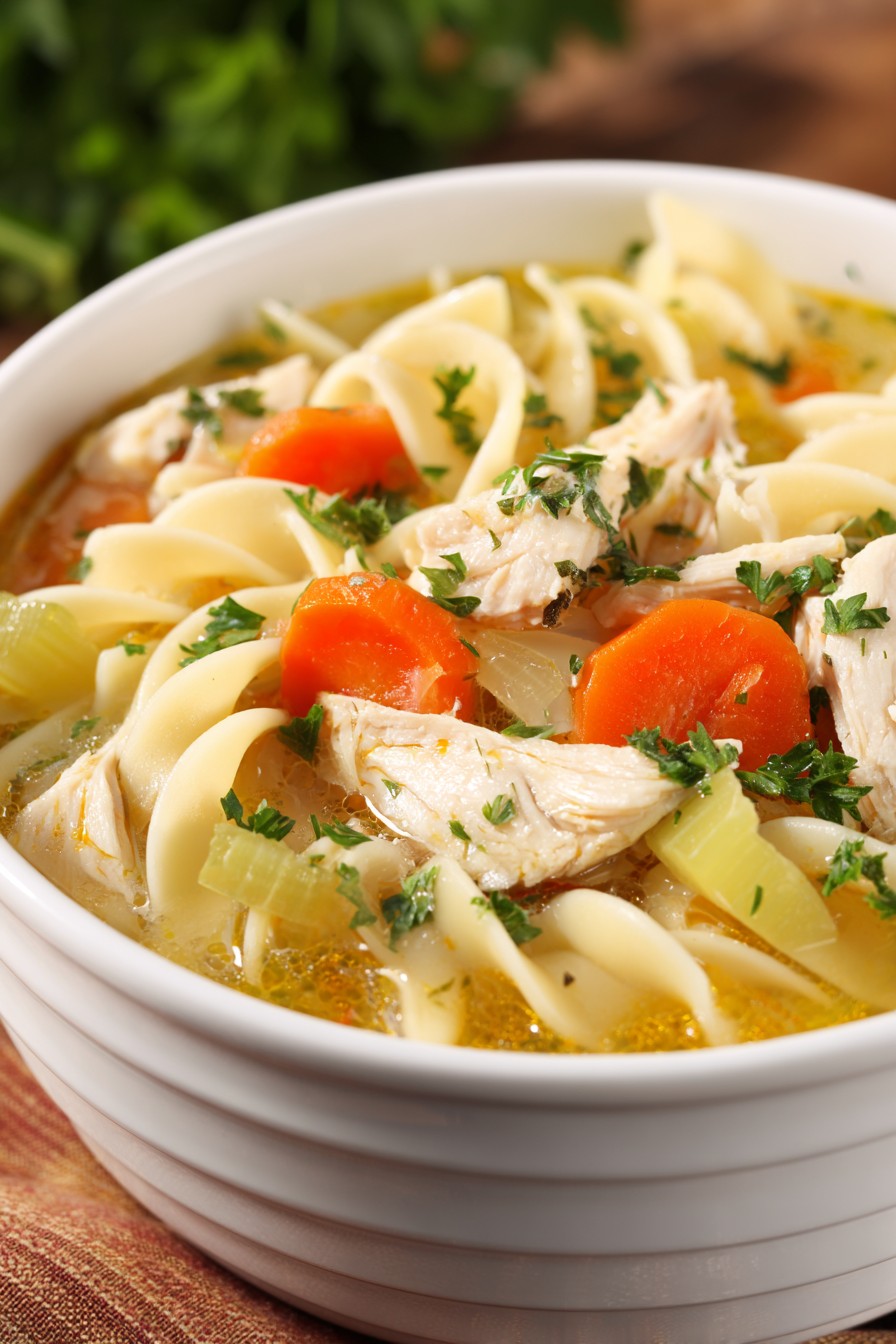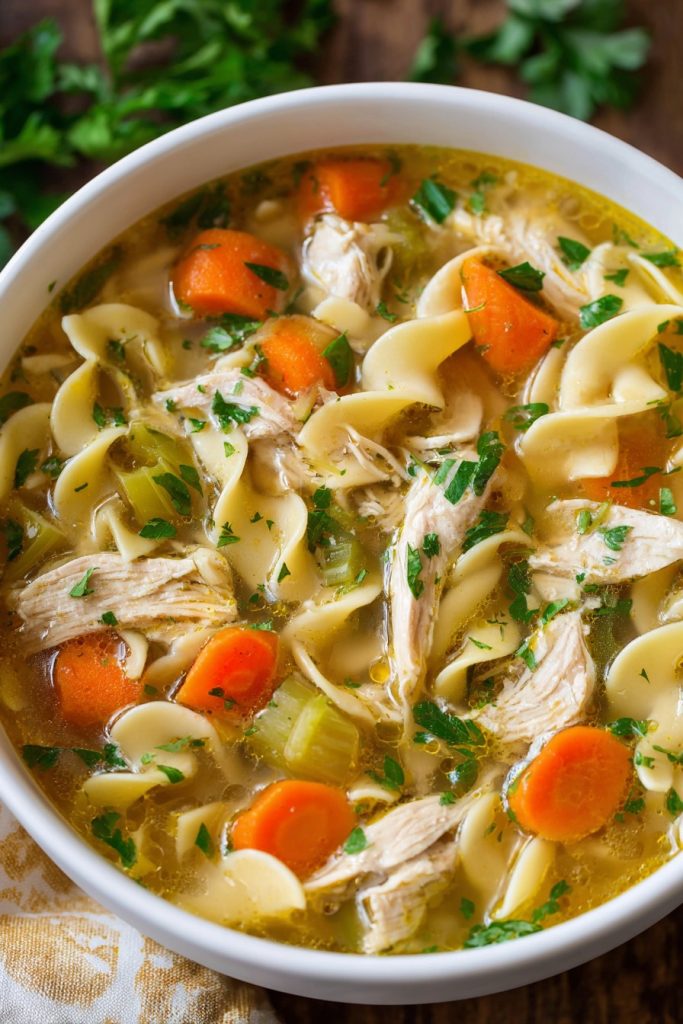Sick days, busy weeknights, or just those moments when you need a hug in a bowl—this canned chicken noodle soup transformation is about to become your new best friend. Seriously, who knew that humble pantry staple could become something so spectacular with just a few simple tricks?
Why This Recipe Works
- Using canned chicken as the base saves you precious prep time while still delivering that classic comfort food flavor we all crave—perfect for when you’re short on time but big on hunger.
- Simmering the broth with fresh aromatics like onions, carrots, and celery infuses it with depth and complexity that makes it taste like it’s been cooking for hours, not minutes.
- Adding egg noodles at just the right moment ensures they cook to perfect tenderness without turning mushy, giving you that ideal soup texture every single time.
- The final touch of fresh herbs brightens everything up and makes this taste far more sophisticated than your average canned soup upgrade.
Ingredients
- 2 cans (12.5 oz each) chunk chicken breast, drained
- 1 tablespoon olive oil
- 1 medium yellow onion, finely diced
- 2 large carrots, peeled and sliced into ¼-inch rounds
- 2 celery stalks, finely chopped
- 3 cloves garlic, minced
- 8 cups chicken broth (low sodium recommended)
- 1 bay leaf
- 1 teaspoon dried thyme
- ½ teaspoon black pepper
- 2 cups wide egg noodles
- ¼ cup fresh parsley, chopped
- Salt to taste
Equipment Needed
- Large stockpot or Dutch oven
- Wooden spoon or spatula
- Cutting board and chef’s knife
- Measuring cups and spoons
- Can opener
- Ladle for serving
Instructions

Step 1: Sauté Your Aromatics
Heat the olive oil in your large stockpot over medium heat until it shimmers—this should take about 2 minutes. Add the diced onion, carrot rounds, and chopped celery, stirring frequently to prevent burning. You’ll want to cook these until the onions turn translucent and the vegetables begin to soften, which typically takes 6-8 minutes. The key here is to develop those sweet, caramelized flavors that will form the foundation of your soup. Keep an eye on the heat to ensure nothing sticks or scorches, adjusting as needed. Tip: If the vegetables start sticking, add a tablespoon of broth to deglaze the pot and scrape up those delicious browned bits.
Step 2: Build Your Flavor Base
Add the minced garlic to the pot and cook for just 60 seconds until fragrant—be careful not to burn it as bitter garlic will ruin your soup. Pour in all 8 cups of chicken broth, then add the drained canned chicken, breaking it up with your spoon into bite-sized pieces. Drop in the bay leaf, dried thyme, and black pepper, then give everything a good stir. Bring the mixture to a boil over high heat, which should take about 5-7 minutes, then immediately reduce to a steady simmer. You’ll know it’s ready for the next step when small bubbles break the surface consistently around the edges of the pot.
Step 3: Cook Your Noodles to Perfection
Once your soup is simmering steadily, add the 2 cups of egg noodles directly to the pot. Stir well to ensure they’re fully submerged in the broth. Cook for exactly 8-10 minutes, stirring occasionally to prevent sticking. The noodles should be tender but still have a slight bite—al dente is what we’re aiming for here. Test a noodle at the 8-minute mark; if it needs more time, continue cooking in 1-minute increments. Remember that the noodles will continue to soften slightly even after you turn off the heat, so err on the side of slightly underdone rather than overdone.
Step 4: Final Seasoning and Herb Addition
Remove the pot from the heat and fish out the bay leaf—it’s done its job and can be discarded. Now taste your soup and season with salt as needed; start with ½ teaspoon and adjust from there since canned chicken and broth vary in saltiness. Stir in the freshly chopped parsley, which will brighten the entire dish with its fresh, herbal notes. Let the soup sit off the heat for 3-5 minutes to allow the flavors to meld together beautifully. This resting period also helps the noodles absorb a bit more broth and reach their ideal texture without becoming mushy.
Step 5: Serve Immediately and Enjoy
Ladle the hot soup into bowls while it’s still piping hot—this is comfort food at its best when served immediately. The ideal serving temperature is around 165°F, hot enough to steam but not so hot that it burns your mouth. If you’re not serving right away, keep the soup warm over very low heat, but note that the noodles will continue to absorb liquid and soften over time. For best results, enjoy within 20 minutes of finishing the recipe. Leftovers can be stored, but the texture will change as the noodles soak up more broth.
Tips and Tricks
If you want to take your canned chicken noodle soup to the next level, consider these pro tips that make all the difference. First, always opt for low-sodium chicken broth—this gives you complete control over the final salt level and prevents your soup from becoming overly salty. Canned products already contain sodium, so starting with a low-sodium base ensures balanced seasoning. Second, don’t skip the step of sautéing your vegetables properly; this develops complex flavors through caramelization that you simply can’t achieve by just boiling everything together. Take the full 6-8 minutes to soften those onions, carrots, and celery—they should release their natural sugars and create a wonderful flavor foundation.
When working with canned chicken, give it a quick rinse under cold water before adding to the soup. This removes excess sodium and that sometimes metallic canned taste, resulting in cleaner chicken flavor. Break the chicken into irregular pieces rather than shredding it completely—this gives better texture and makes it feel more like homemade. For the noodles, consider cooking them separately if you plan to have leftovers. Cook the noodles in a separate pot of boiling water until al dente, then add them to individual bowls before ladling hot soup over top. This prevents them from becoming mushy when stored and reheated.
Fresh herbs make a massive difference here—while dried parsley works in a pinch, fresh parsley added at the end provides a bright, clean flavor that cuts through the richness. If you have other fresh herbs like dill or thyme, feel free to add a tablespoon of those too. For extra depth, add a parmesan rind to the soup while it simmers—it will melt into the broth and add incredible umami flavor. Finally, always taste and adjust seasoning at the end rather than at the beginning. Canned products vary so much that you need to wait until everything comes together before deciding on final salt levels.
Recipe Variations
- Creamy Chicken Noodle Soup: Stir in ½ cup of heavy cream or full-fat coconut milk during the last 2 minutes of cooking for a rich, velvety version. Add a tablespoon of lemon juice at the end to balance the richness. This variation turns your soup into something truly decadent while still maintaining that classic comfort food appeal.
- Spicy Southwest Twist: Add 1 teaspoon cumin, ½ teaspoon chili powder, and a 4-ounce can of diced green chiles with the broth. Stir in 1 cup of frozen corn and a 15-ounce can of rinsed black beans during the last 5 minutes of cooking. Top with avocado slices and tortilla strips for serving.
- Italian Wedding Style: Add ½ pound of cooked Italian sausage crumbles with the chicken, and use ditalini pasta instead of egg noodles. Stir in 2 cups of fresh spinach during the last 2 minutes of cooking until wilted. Finish with a sprinkle of grated parmesan cheese and red pepper flakes.
- Asian-Inspired Version: Replace egg noodles with 2 bundles of ramen noodles (discard seasoning packets). Add 1 tablespoon grated ginger with the garlic, and use 6 cups chicken broth + 2 cups coconut milk. Finish with 2 tablespoons soy sauce, 1 tablespoon lime juice, and top with sliced scallions and cilantro.
Frequently Asked Questions
Can I use fresh chicken instead of canned?
Absolutely! While this recipe is designed for canned chicken convenience, you can substitute 2 cups of shredded cooked chicken breast. If using raw chicken, dice 1 pound of boneless skinless chicken breasts and cook with the vegetables in step 1 until no longer pink, about 8-10 minutes. The soup may need an additional 5 minutes of simmering time to ensure the chicken is fully cooked through. Using fresh chicken will give you a cleaner flavor profile, but the canned version works surprisingly well when you’re short on time.
How should I store and reheat leftovers?
Store cooled soup in an airtight container in the refrigerator for up to 4 days. The noodles will continue to absorb broth, so you may need to add additional chicken broth when reheating. To reheat, place desired portion in a saucepan over medium heat, stirring occasionally until heated through to 165°F, about 8-10 minutes. Alternatively, microwave in 1-minute intervals, stirring between each, until hot. I don’t recommend freezing this soup as the noodles become mushy upon thawing. If you plan to freeze, leave out the noodles and add fresh cooked noodles when reheating.
Can I make this soup in a slow cooker?
Yes, with some modifications! Sauté the vegetables as directed in step 1, then transfer everything except the noodles to your slow cooker. Cook on low for 6-8 hours or high for 3-4 hours. Add the egg noodles during the last 30 minutes of cooking on high or 45 minutes on low, ensuring they’re fully submerged. The noodles may require additional cooking time depending on your slow cooker, so check for doneness at the 20-minute mark. This method works well for meal prep or when you want dinner waiting for you after a long day.
What can I use if I don’t have egg noodles?
Several alternatives work beautifully! Try using 2 cups of ditalini, orzo, or small shell pasta—adjust cooking time according to package directions. For gluten-free options, use brown rice noodles or gluten-free pasta, cooking them separately to prevent clouding the broth. If you’re watching carbs, spiralized zucchini or spaghetti squash make excellent low-carb alternatives; add these during the last 2-3 minutes just to heat through. The soup will work with almost any pasta shape, though cooking times may vary, so always check for doneness frequently.
Summary
This canned chicken noodle soup transformation proves that pantry staples can become extraordinary meals with just a few smart techniques. Perfect for busy weeknights or when comfort food cravings strike!
Canned Chicken Noodle Soup
5
servings10
minutes25
minutesIngredients
Instructions
- 1 Heat olive oil in large pot over medium heat. Add onion, carrots, and celery; cook 6-8 minutes until softened.
- 2 Add garlic; cook 1 minute until fragrant. Add broth, chicken, bay leaf, thyme, and pepper. Bring to boil then reduce to simmer.
- 3 Add egg noodles; cook 8-10 minutes until al dente, stirring occasionally.
- 4 Remove bay leaf. Season with salt to taste. Stir in fresh parsley.
- 5 Let rest 5 minutes before serving hot.



